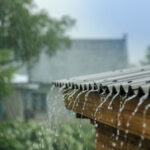 The rainy season can bring much-needed relief from scorching summer days, but it also presents a unique set of challenges for homeowners. Among these challenges, one of the most pressing is protecting your home from water damage, especially your roof. A well-maintained roof is essential for safeguarding your home from leaks and mold growth. In this blog, we’ll explore some key strategies and tips to ensure your roof is ready to face the rainy season head-on.
The rainy season can bring much-needed relief from scorching summer days, but it also presents a unique set of challenges for homeowners. Among these challenges, one of the most pressing is protecting your home from water damage, especially your roof. A well-maintained roof is essential for safeguarding your home from leaks and mold growth. In this blog, we’ll explore some key strategies and tips to ensure your roof is ready to face the rainy season head-on.
1. Schedule a Roof Inspection
Before the rainy season hits, it’s crucial to schedule a professional roof inspection. A qualified roofing contractor can assess the current condition of your roof, identifying any potential trouble spots that might lead to leaks or water damage. They’ll look for loose or damaged shingles, deteriorated flashing, and signs of wear and tear. Addressing these issues proactively can prevent more significant problems during heavy rains.
2. Clean Your Gutters
Maintaining clean gutters is an often-overlooked but essential aspect of rainy season roof care. When gutters are clogged with leaves, debris, or dirt, water can’t flow properly, causing it to overflow and potentially damage your roof. The excess water can seep under the shingles, causing rot, leaks, and even structural damage. Regularly clean your gutters and ensure they’re free of blockages to enable proper drainage.
3. Repair or Replace Damaged Shingles
If your roof inspection reveals damaged or missing shingles, don’t delay in addressing the issue. Damaged shingles can lead to water infiltration, which can result in leaks and mold growth. Have a professional roofer replace the damaged shingles promptly to maintain your roof’s integrity and keep your home dry during the rainy season.
4. Check for Proper Ventilation
Adequate roof ventilation is essential to prevent moisture buildup in your attic, which can lead to mold growth and roof damage. Ensure that your attic is well-ventilated and that the vents are clear of obstructions. Proper ventilation not only protects your roof but also helps regulate your home’s temperature, making it more energy-efficient.
5. Seal Roof Penetrations
Your roof has various penetrations, such as vents, chimneys, and skylights. These areas are prone to leaks if not properly sealed. Inspect the seals around these penetrations and make sure they are in good condition. If you notice any cracks or gaps, reseal them with the appropriate roofing sealant to prevent water from entering your home.
6. Trim Overhanging Branches
Overhanging branches can pose a significant risk to your roof during the rainy season. Falling branches or limbs can cause severe damage, leading to leaks and costly repairs. Trim back any branches that hang over your roof, ensuring they are a safe distance away to prevent accidents and damage.
7. Install Roof Underlayment
A roof underlayment is a water-resistant barrier installed beneath your roofing material, such as shingles or tiles. It provides an extra layer of protection against water intrusion and can be especially beneficial during heavy rain. If your roof doesn’t already have an underlayment, consider having one installed to enhance your roof’s ability to repel water.
8. Invest in Quality Flashing
Flashing is a material that seals the joints and transitions in your roof, such as around chimneys and vents. It prevents water from seeping into these vulnerable areas. Quality flashing is crucial in preventing leaks. If your roof’s flashing is old or deteriorating, have it replaced to ensure your home remains watertight.
9. Monitor for Mold and Mildew
Even with proper precautions, mold and mildew can still become issues during the rainy season. Keep an eye out for any signs of mold growth in your home, especially in the attic or ceiling. If you notice any mold or mildew, address it promptly to prevent it from spreading and causing structural damage.
10. Consider a Roof Coating
For added protection during the rainy season, you might want to consider applying a roof coating. Roof coatings create a waterproof barrier and can extend the lifespan of your roof. They are especially useful for flat or low-slope roofs, which are more susceptible to water damage.
Summary
Taking care of your roof during the rainy season is vital to protect your home from water damage, leaks, and mold growth. Regular inspections, proper maintenance, and proactive measures can go a long way in ensuring your roof’s longevity and your home’s comfort and safety. By following these tips and staying vigilant, you can keep your home dry and secure, even when the rain is pouring outside. Remember, a well-maintained roof is an investment in the long-term health of your home.
Need a Roofing Contractor in Florida?
Winter Springs Roofing & Repair has provided our customers quality roofing and chimney services since 1983. Our services include tile roof repairs, tile restoration, chimney repair, skylight repairs, re-roofs, roof repairs and carpentry, low sloped roof services, and commercial maintenance and restoration. We are BBB accredited: ST CERT CCC1330777 – ST LIC RC29027154. Call us today for immediate service!